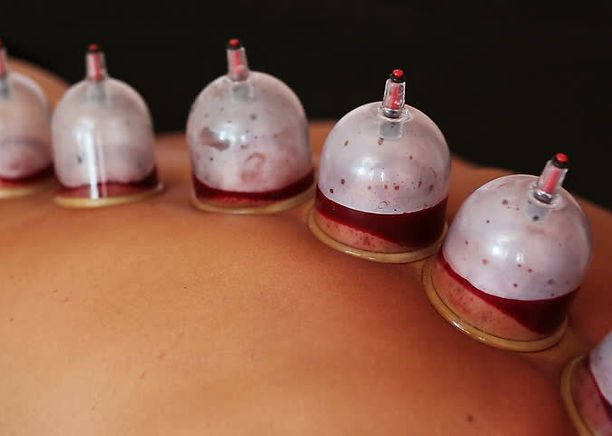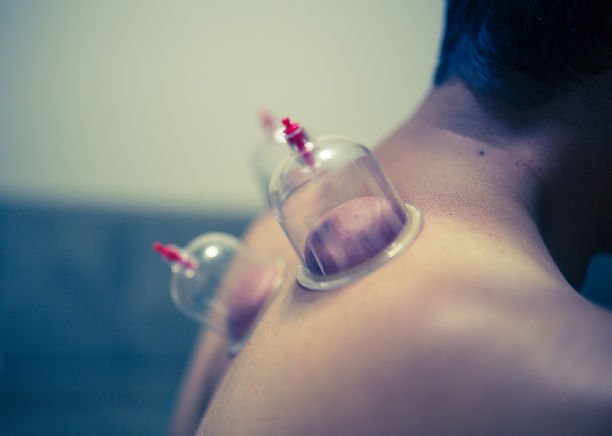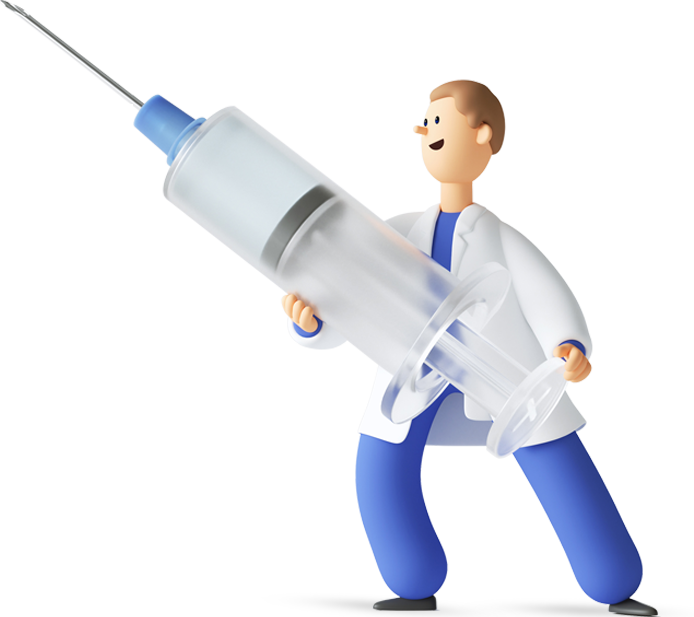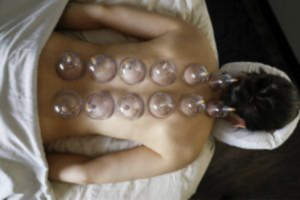Hijama (Wet/Dry Cupping) has been used all over the world to treat health conditions for thousands of years. You may have seen people with red circular marks (not bruises!) from Hijama on their shoulders and backs. A lot of people have questions about the benefits of Hijama and wonder what it’s like.
At the Integrative Medicine & Hijama Clinic, we use Hijama to help reduce the common acute and chronic illnesses that patients experience and provide relief from muscle pain, edema, and digestive complaints, chronic conditions as well as acute management.
We practice Hijama using Negative Pressure Massage Hijama. This is accomplished by using smooth cups made of either glass or silicone. The Hijamist will place cups on your skin along anatomical meridian points based on your consultation. Then, create a gentle suction that draws your skin upward into the cup. The first ten minutes will provide dry suction, whereas the next two 10 minute sessions, if applicable, wet cupping will take place. The whole experience should be expected to take 60 minutes.

Hijama Wet Cupping
Wet Cupping (or ‘Hijaamah’ in Arabic) is an ancient holistic therapy which involves removing blood from the body at certain therapeutic points.
It is achieved by making very light superficial scratches on the skin with a sterile surgical blade, then applying a cup over the scratches, whilst drawing a vacuum inside it to stimulate the extraction of a small quantity of blood.
This unique treatment can have many benefits for the body.

Dry Cupping
Made popular by celebrities in recent years, dry cupping is currently enjoying a huge revival.
This treatment is very similar to Hijama but doesn’t involve the removal of blood. It’s therefore a great introductory therapy to try. The cups can also be of glass, applied using a flame.
Cups are attached to the body directly over the areas of pain, swelling or stiffness and left in position for a short period of time.

Why Hijama?
Moving cupping is a unique form of deep tissue massage which can be deeply relaxing. Moving cupping may help improve muscular aches and stiffness.
Light-medium vacuum pressure is applied so that the cup can be moved across the surface of the skin without breaking suction.
Circular movements, or linear motions which follow the natural alignment of key muscle groups, are typically used.
The suction will feel tight at first (not painful) while it draws your skin up into the cup. That sensation passes quickly as your Hijamist moves on to place the next cup. After placing each cup on your trigger points, the Hijamist will repeat the suction process. They’ll always check to make sure you’re still comfortable.
When using glass cups, some therapists use heat (“fire Hijama”) to create a vacuum, but we use an apparatus that simply draws out the air out of the cup. You’ll hear it make a small clicking sound as we use the apparatus to create the suction.
Quite rapidly, your body will acclimate to the feeling of the cups. You probably won’t even feel every single cup that has been placed. The number of cups the Hijamist uses will depend on what is being treated. If it’s your first time trying Hijama, we will likely use fewer cups for a less intense treatment.
Will leave the cups in place for 10 minutes, depending on your specific need. When it’s time to remove the cups, release the pressure from the cup and set it aside. The release of pressure often feels calming, or like your body feels lighter and less tense.
Sometimes, the Hijamist will apply lotion or oil to your skin and create a lesser pressure so the cups can glide across your skin. This is called “moving Hijama.” Moving Hijama is often used for treating digestion, inflammation, and congestion. The Hijamist will glide the cups toward your lymph glands, as a way of helping your body expel toxins and waste through your lymphatic system.
While the cups are on your skin, they loosen and lift your connective tissues, which increases blood and lymph flow to your skin and muscles. The targeted blood flow brings oxygen rich blood and lymph to the affected area. Your lymphatic system is responsible for clearing the cellular waste and toxins from your body. Hijama gives your body an extra boost in clearing toxins. You can read about more benefits of Hijama on our website.
It’s important to understand that the red circular marks left behind by the cups are NOT bruises. They very rarely hurt. Bruises are caused by impact trauma that breaks capillaries in the injured area. But there is NO compression or impact trauma when Hijama is done correctly. In fact, Hijama does the opposite. Instead of compressing/pushing your skin and muscles, it lifts/pulls your skin and tissues.
The red marks are a result of the blood being pulled into that area. The darker the mark, the more stagnant fluids (toxins, blood and lymph) were dredged up during treatment. The marks last anywhere from a few hours to several days. The more often you receive Hijama for the same issue, the lighter the marks will be.
We will give you a more detailed after-care guide at the end of your session. But here’s the general care:
- Hydrate, hydrate, hydrate! Give your lymphatic system the extra fluids it needs to flush your body of the toxins
- Don’t shower immediately after Hijama.
- No red meat or fried, fatty, processed foods for 24 hrs
- Keep the areas that were treated covered and warm.
- Avoid alcohol.
- You may feel fatigued or experience flu-like symptoms the next day. This is normal. It’s your body processing and expelling the toxins that were released during your Hijama session. Take it easy, get extra rest, and practice good self-care. Your body will thank you!
Curious if Hijama could help you? Give us a call. You can choose to have a Hijama-only session, or add Hijama on to your regular doctor’s visit (since we are also a primary care clinic).











